What is a Trojan Moon?
Before we dive into the Polydeuces moon, let’s first understand what is meant by the term Trojan Moon. Trojans are any astronomical object that shares an orbit with another bigger body. They can be asteroids, moons, or even, hypothetically, planets. These are not the only requirements though. Remember that a trojan basically shares an orbit with a bigger object. A collision between these bodies is avoided because trojans lie in, or close to, the stable Lagrangian points. That way, the harmonious relationship between these co-orbiting bodies is maintained.
So, What Are Lagrange Points?
The Lagrange points are five locations around two large bodies like the Earth and the Sun. They are also called Lagrangian points or “L points.”
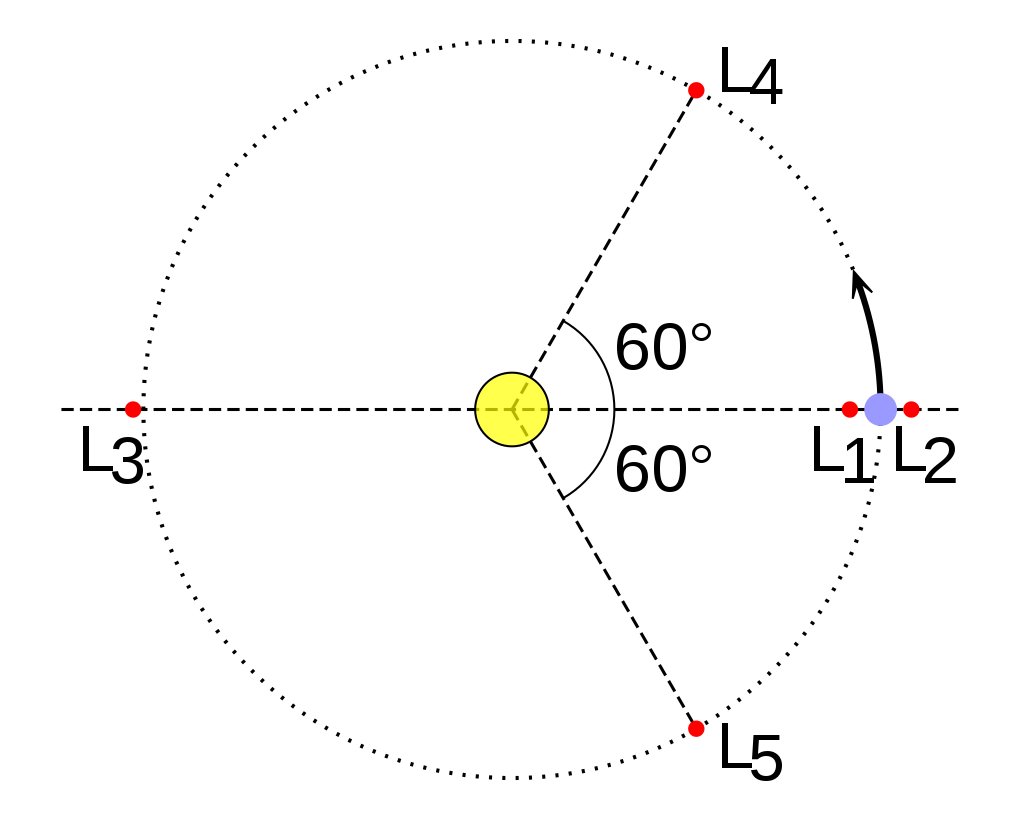
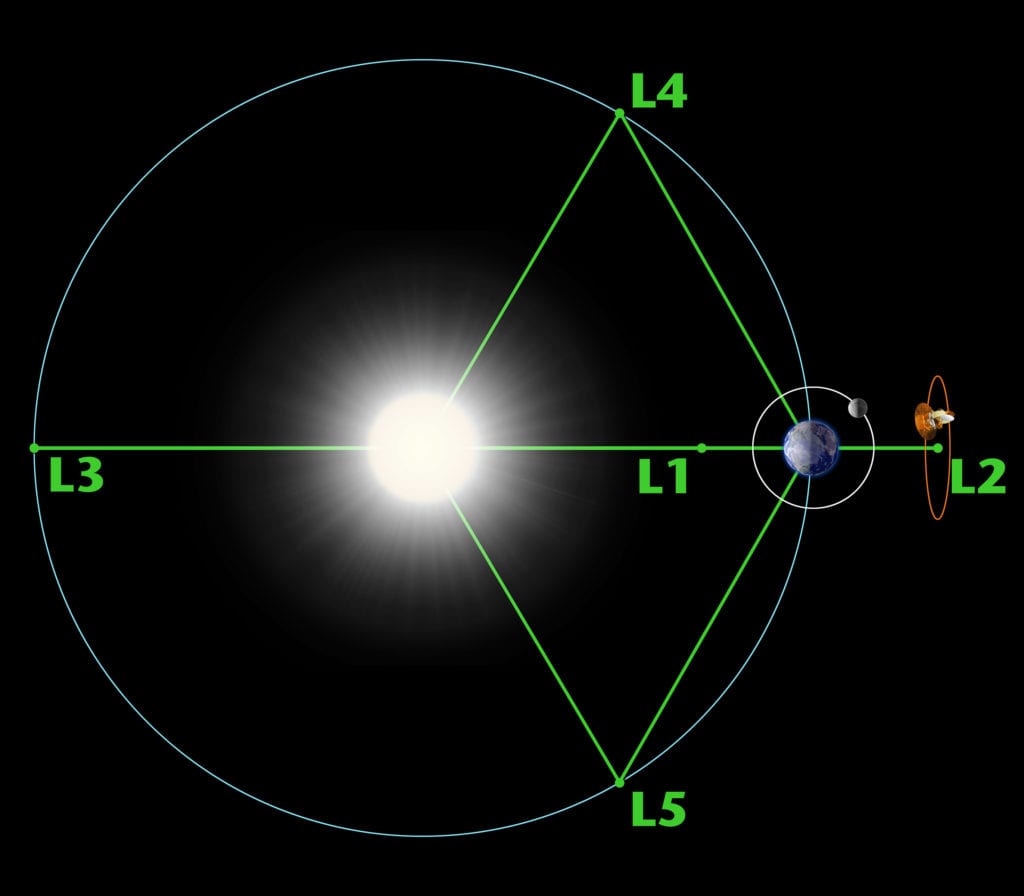
The Lagrange points also exist in other large orbiting bodies in the solar system. It can be found in relationships such as a planet and the Sun, a moon and its planet, and even a small moon and a much bigger moon. And since these bodies are spread far and wide in space, each system has different sets of Lagrange points.
The Lagrange points of the Sun-Earth system are different from that of the Earth and the Moon. The same thing applies to the Saturnian system and its moons.
The Lagrangian Points
L1 – Located between the two large masses.
L2 – Also located on the same line that connects the two large objects. However, it lies behind the smaller body.
L3 – Located beyond the bigger of the two bodies.
L4 – Lies 60 degrees ahead of the smaller body.
L5 – Lies 60 degrees behind the smaller body of the two.
L1, L2, and L3 are unstable points while the stable points are L4 and L5. The stable points are achieved as long as the ratio between the two large masses is more than 24.96.
The Earth’s unstable points, L1 and L2, have been known as good spots for spacecraft and artificial satellites. Aside from providing a great view for observing the Sun and our planet, staying near such regions require less fuel to stay in position than in non-Lagrange points. L3 has not been used yet as it is hidden beyond the Sun.
The Trojans
The stable Lagrange points tend to attract astronomical objects close to them. As a result, asteroids and moons have been observed staying in different L4 and L5 points in the solar system. Objects staying close to these points are called trojans.
The most common example of this is the Jupiter trojans. These asteroids stay 60 degrees ahead and behind Jupiter as the gas giant orbit around the Sun. This relationship also occurs among moons.
Smaller moons can share an orbit with a bigger one as they circle their parent planet. This relationship has been discovered only in the Saturnian system. The moon Tethys has two trojans, Telesto and Calypso. The other co-orbital moons are Helene and Polydeuces, staying ahead and behind Dione respectively.
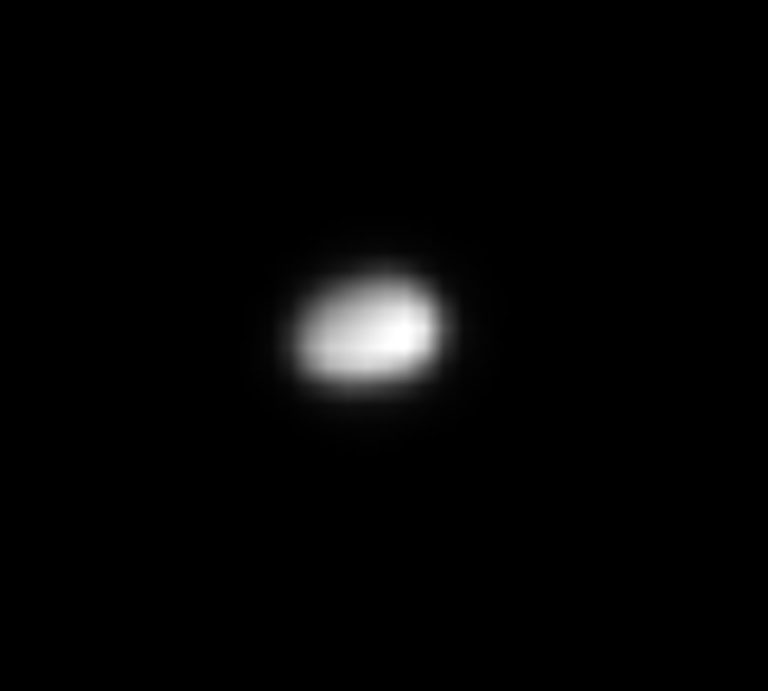
The Polydeuces Moon
Polydeuces Moon: Facts and Figures
All About the Name
- Pronunciation – /ˌpɒlɪˈdjuːsiːz/
- Behind the name – Polydeykēs ( From Castor and Pollux in Greek mythology)
- Adjective/s – Polydeucean / Polydeucian
- Other designation/s – Saturn XXXIV; Dione C
- Provisional designation – S/2004 S 5
Discovery Details
- Discoverer/s – Cassini Imaging Team
- Discovery date – October 21, 2004
Orbital Characteristics
- Parent planet – Saturn
- Orbital period – 2.736915 day/s
- Average orbit distance – 377, 200 km
- Mean orbit velocity – 36,076.6 km/h
- Eccentricity – 0.0192
- Orbital inclination – 0.1774 ± 0.0015°
Physical Features
- Dimensions – 3 × 2.5 × 2 km
- Equatorial radius – 1.3 ± 0.4 km
- Equatorial circumference – 8.2 km
- Volume – 9 km3
- Mass – 4,496,005,299,292 kg
- Surface area – 21.24 km2
- Surface gravity – 0.00018 m/s2
- Escape Velocity – 2 km/hr
- Rotation – Synchronous (assumed)
Polydeuces Moon Features
Polydeuces is the trailing trojan of the bigger moon Dione. It is also called Saturn XXXIV. This moon was discovered in 2004 through the Cassini-Huygens mission.
Dione has another trojan moon ahead of it, Helene. This leading trojan is bigger than Polydeuces. Another name for Polydeuces is Dione C because it trails behind Dione in its orbit.
The libration of Polydeuces is distinct among the other trojan moons of the system. While it is known that L5 is behind the large body by 60 degrees, Polydeuces strays as much as 33.9° to 91.4° behind Dione.
The adjectives used for this moon are Polydeucean and Polydeucian.
Did You Know?
Polydeuces’s co-orbital moon, Dione, is Saturn’s fourth-largest moon.
1. Titan
2. Rhea
3. Iapetus
4. Dione
5. Tethys
6. Enceladus
7. Mimas
Polydeuces Moon Discovery
The Cassini Imaging Science Team discovered Dione on October 21, 2004. Its provisional or temporary designation was S/2004 S 5 as it was the 5th natural satellite of Saturn discovered in 2004. The team, headed by Carolyn Porco, then reviewed earlier images taken by the Cassini probe to check if the moon had already been seen before.
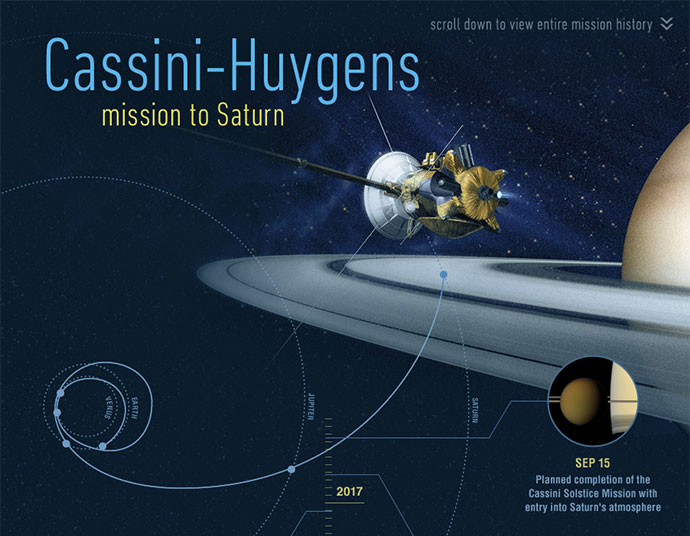
Previous images taken earlier that year showed the same moon. The Cassini spacecraft caught a glimpse of Polydeuces on April 9, 2004.
Other moons of Saturn discovered in the same year using Cassini images are Methone and Pallene. By also taking a step back and reviewing earlier images, it was found out that Pallene was photographed by Voyager 2 as early as August 23, 1981.
Polydeuces Moon Characteristics
Size
Polydeuces has a mean radius of 1.3 km. Its dimension is 3 × 2.5 × 2 km. This moon is smaller than Dione by 432 times. It is also smaller than the other trojan, Helene, by about 13.5 times.
Polydeuces’s equatorial circumference 1.3 km, with a mass of 4,496,005,299,292 kg. Its surface area is 21.24 km2. Scientists assume that this moon is in a synchronous rotation and is, therefore, tidally locked to Saturn.
Composition
The composition of Polydeuces is not yet known. However, it is believed to be comparable to Methone which is also affected by the Mimas moon.
There may be hydrostatic equilibrium on the surface of Polydeuces. But this may not be the same in its interior. Much about it is yet to be confirmed as future missions explore the Saturnian system.
Orbit
Polydeuces has an average orbit distance of 377, 200 km. It takes nearly three days for this moon to complete a trip around the ringed planet.
The orbit of Polydeuces is affected by the moon’s libration. It can change by about ±7,660 km in relation to Dione’s orbit. Unlike other trojan moons that stay about 60 degrees from the bigger moon, Polydeuces can either stay as close to Dione by 39 degrees or as far as 92 degrees.
Role/Other Features
Polydeuces stays in the L5 Lagrange point of Dione around Saturn. Its wandering nature is unlike any other that was observed in the other trojan moons.
What Does Polydeuces Look Like?
 The moon Polydeuces is believed to be irregularly shaped. Since it hasn’t been photographed up close, surface features and other details about this moon are still unknown.
The moon Polydeuces is believed to be irregularly shaped. Since it hasn’t been photographed up close, surface features and other details about this moon are still unknown.
The best look we have of this tiny moon was taken by Cassini on May 22, 2006. It was not a major flyby as the spacecraft was roughly 73,000 km away from Polydeuces. The image has a scale of 434 meters per pixel. And with a size so small, the imaging team had to magnify it four times so we can have a better look at the moon.
Behind the Name
The name Polydeuces had its origin in Greek and Roman mythology. The small moon was given this name on January 21, 2005, as approved by the International Astronomical Union (IAU). It was based on the story of the twins, Castor and Pollux. The latter was called Polydeukes in Greek mythology.
Polydeuces in Mythology
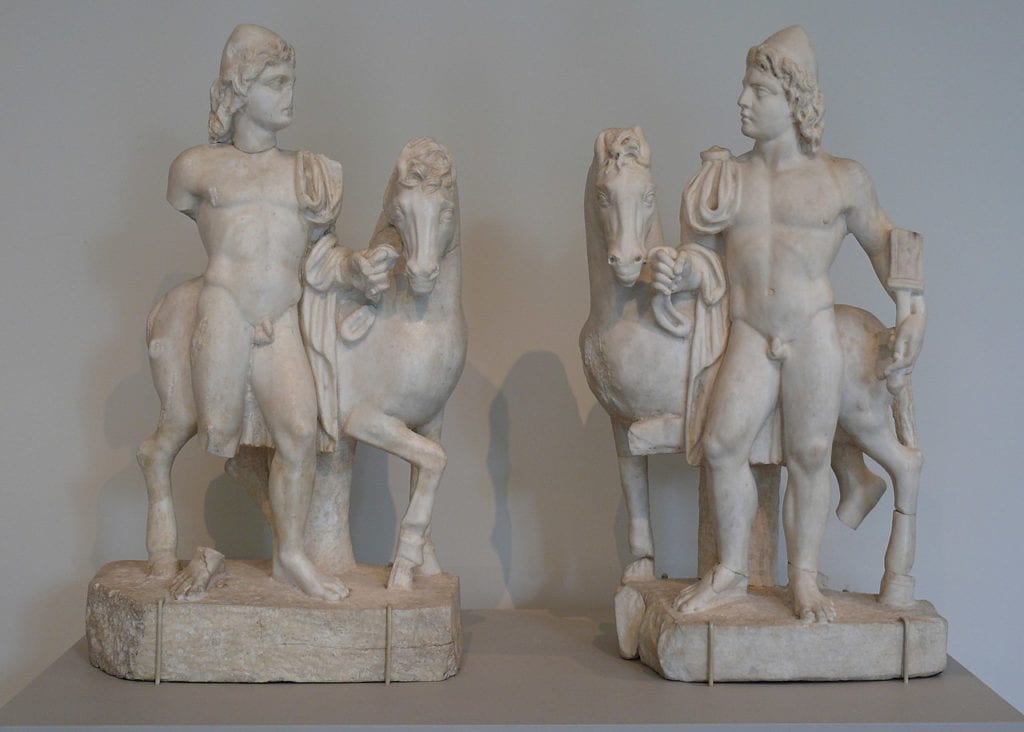 Castor and Pollux are known together as the Dioscuri. Even though they are twins, they are half brothers because they have different fathers. Leda, a Spartan queen, was their mother.
Castor and Pollux are known together as the Dioscuri. Even though they are twins, they are half brothers because they have different fathers. Leda, a Spartan queen, was their mother.
Castor’s father was the king of Sparta, Tyndareus. Pollux, on the other hand, was the son of Zeus. The king of the gods seduced the queen when he was in the form of a swan. Their twin sisters Helen and Clytemnestra had the same parentage as them. They had other sisters, Phoebe, Timandra, and Philonoe.
Castro and Pollux appeared in different stories throughout Greek mythology. They became a part of the adventure of Jason and the Argonauts. They also rescued their sister Helen when, in her younger years, she was kidnapped by Theseus.
The constellation Gemini is related to the Dioscuri. It was said that Pollux asked a favor from his father, Zeus, to help his dying brother. The king god heard his plea and made them the brightest stars in the twin’s constellation, Gemini.
Statistical Sources:
- https://en.wikipedia.org/wiki/Polydeuces_(moon)
- https://solarsystem.nasa.gov/moons/saturn-moons/polydeuces/by-the-numbers/
- https://solarsystem.nasa.gov/moons/saturn-moons/polydeuces/in-depth/
- https://en.wikipedia.org/wiki/Lagrange_point#L1_point
- https://photojournal.jpl.nasa.gov/catalog/?IDNumber=PIA08209
- https://en.wikipedia.org/wiki/Castor_and_Pollux#Mythology
Image Sources:
- Lagrange points:https://en.wiktionary.org/wiki/Trojan_point
- Lagrange points (with contours):https://solarsystem.nasa.gov/resources/754/what-is-a-lagrange-point/
- Polydeuces moon; what it looks like: https://solarsystem.nasa.gov/moons/saturn-moons/polydeuces/in-depth/
- Cassini-Huygens: https://solarsystem.nasa.gov/news/12743/a-scroll-through-memory-lane-with-cassini/
- Castor and Pollux: https://en.wikipedia.org/wiki/Castor_and_Pollux